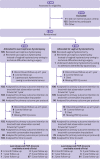Sacrospinous hysteropexy versus vaginal hysterectomy with uterosacral ligament suspension in women with uterine prolapse stage 2 or higher: observational follow-up of a multicentre randomised trial
- PMID: 31506252
- PMCID: PMC6734519
- DOI: 10.1136/bmj.l5149
Sacrospinous hysteropexy versus vaginal hysterectomy with uterosacral ligament suspension in women with uterine prolapse stage 2 or higher: observational follow-up of a multicentre randomised trial
Abstract
Objective: To evaluate the effectiveness and success of uterus preserving sacrospinous hysteropexy as an alternative to vaginal hysterectomy with uterosacral ligament suspension in the surgical treatment of uterine prolapse five years after surgery.
Design: Observational follow-up of SAVE U (sacrospinous fixation versus vaginal hysterectomy in treatment of uterine prolapse ≥2) randomised controlled trial.
Setting: Four non-university teaching hospitals, the Netherlands.
Participants: 204 of 208 healthy women in the initial trial (2009-12) with uterine prolapse stage 2 or higher requiring surgery and no history of pelvic floor surgery who had been randomised to sacrospinous hysteropexy or vaginal hysterectomy with uterosacral ligament suspension. The women were followed annually for five years after surgery. This extended trial reports the results at five years.
Main outcome measures: Prespecified primary outcome evaluated at five year follow-up was recurrent prolapse of the uterus or vaginal vault (apical compartment) stage 2 or higher evaluated by pelvic organ prolapse quantification system in combination with bothersome bulge symptoms or repeat surgery for recurrent apical prolapse. Secondary outcomes were overall anatomical failure (recurrent prolapse stage 2 or higher in apical, anterior, or posterior compartment), composite outcome of success (defined as no prolapse beyond the hymen, no bothersome bulge symptoms, and no repeat surgery or pessary use for recurrent prolapse), functional outcome, quality of life, repeat surgery, and sexual functioning.
Results: At five years, surgical failure of the apical compartment with bothersome bulge symptoms or repeat surgery occurred in one woman (1%) after sacrospinous hysteropexy compared with eight women (7.8%) after vaginal hysterectomy with uterosacral ligament suspension (difference-6.7%, 95% confidence interval -12.8% to-0.7%). A statistically significant difference was found in composite outcome of success between sacrospinous hysteropexy and vaginal hysterectomy (89/102 (87%) v 77/102 (76%). The other secondary outcomes did not differ. Time-to-event analysis at five years showed no differences between the interventions.
Conclusions: At five year follow-up significantly less anatomical recurrences of the apical compartment with bothersome bulge symptoms or repeat surgery were found after sacrospinous hysteropexy compared with vaginal hysterectomy with uterosacral ligament suspension. After hysteropexy a higher proportion of women had a composite outcome of success. Time-to-event analysis showed no differences in outcomes between the procedures.
Trial registration: trialregister.nl NTR1866.
Published by the BMJ Publishing Group Limited. For permission to use (where not already granted under a licence) please go to http://group.bmj.com/group/rights-licensing/permissions.
Conflict of interest statement
Competing interests: All authors have completed the ICMJE uniform disclosure form at http://www.icmje.org/coi_disclosure.pdf and declare: no support from any organisation for the submitted work; no financial relationships with any organisations that might have an interest in the submitted work in the previous three years, no other relationships or activities that could appear to have influenced the submitted work. HWFvE receives honorariums as trainer for Coloplast and BARD outside the submitted work.
Figures


References
-
- Wu JM, Hundley AF, Fulton RG, Myers ER. Forecasting the prevalence of pelvic floor disorders in U.S. Women: 2010 to 2050. Obstet Gynecol 2009;114:1278-83. - PubMed
-
- Giri A, Hartmann KE, Hellwege JN, Velez Edwards DR, Edwards TL. Obesity and pelvic organ prolapse: a systematic review and meta-analysis of observational studies. Am J Obstet Gynecol 2017;217:11-26.e3. - PubMed
-
- Olsen AL, Smith VJ, Bergstrom JO, Colling JC, Clark AL. Epidemiology of surgically managed pelvic organ prolapse and urinary incontinence. Obstet Gynecol 1997;89:501-6. - PubMed
-
- Smith FJ, Holman CD, Moorin RE, Tsokos N. Lifetime risk of undergoing surgery for pelvic organ prolapse. Obstet Gynecol 2010;116:1096-100. - PubMed
-
- van IJsselmuiden MN, Detollenaere RJ, Kampen MY, Engberts MK, van Eijndhoven HW. Practice pattern variation in surgical management of pelvic organ prolapse and urinary incontinence in The Netherlands. Int Urogynecol J 2015;26:1649-56. - PubMed
Publication types
MeSH terms
LinkOut - more resources
Full Text Sources
Other Literature Sources
Medical
